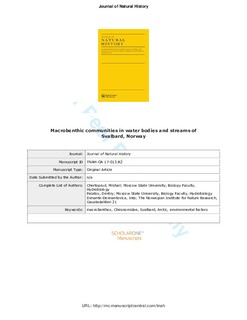Macrobenthic communities in water bodies and streams of Svalbard, Norway
Journal article, Peer reviewed
Accepted version

Åpne
Permanent lenke
http://hdl.handle.net/11250/2468244Utgivelsesdato
2017Metadata
Vis full innførselSamlinger
- Publikasjoner fra CRIStin - NINA [2364]
- Scientific publications [1392]
Originalversjon
10.1080/00222933.2017.1395092Sammendrag
Diversity of macrobenthic communities was studied from water bodies and streams of Spitsbergen, Svalbard archipelago, Norway. In total 162 quantitative samples from different regions of Spitsbergen were analysed in relation to environmental variables. Macrobenthic communities were found on all kinds of substrates (except for the periglacial zone), representing a wide range of biological communities: solid-bottom, soft-bottom, macrophytes and small brook associated. However, taxonomical structure is very simplified, with particular dominance of the Chironomidae family. Chironomid larvae dominated highly in diversity, abundance and biomass. Overall macrobenthic communities were characteristic, with remarkable dominance of one species and general omnipresent taxonomical scarcity (averagem 2.8 species per sample). In total we found 30 taxa. We distinguished 16 types of macrobenthis communities, with characteristic dominance of different taxa: chironomids (11 types), oligochaete Enchytraeidae family (3), caddisfly Apatania zonella (1) and gammarid amphipod Gammarus setosus (1). Regarding environmental variables, temperature and pH had the most significant influence on the abundance of macrobenthic organisms. It is hypothesized that the structural convergence of different types of communities is their common response to extreme high Arctic living conditions. On the other hand, different chironomids may dominate in the same habitats and water bodies. This gives the effect of lower average similarity of communities and high β- diversity. Macrobenthos Chironomidae Svalbard Arctic environmental factors